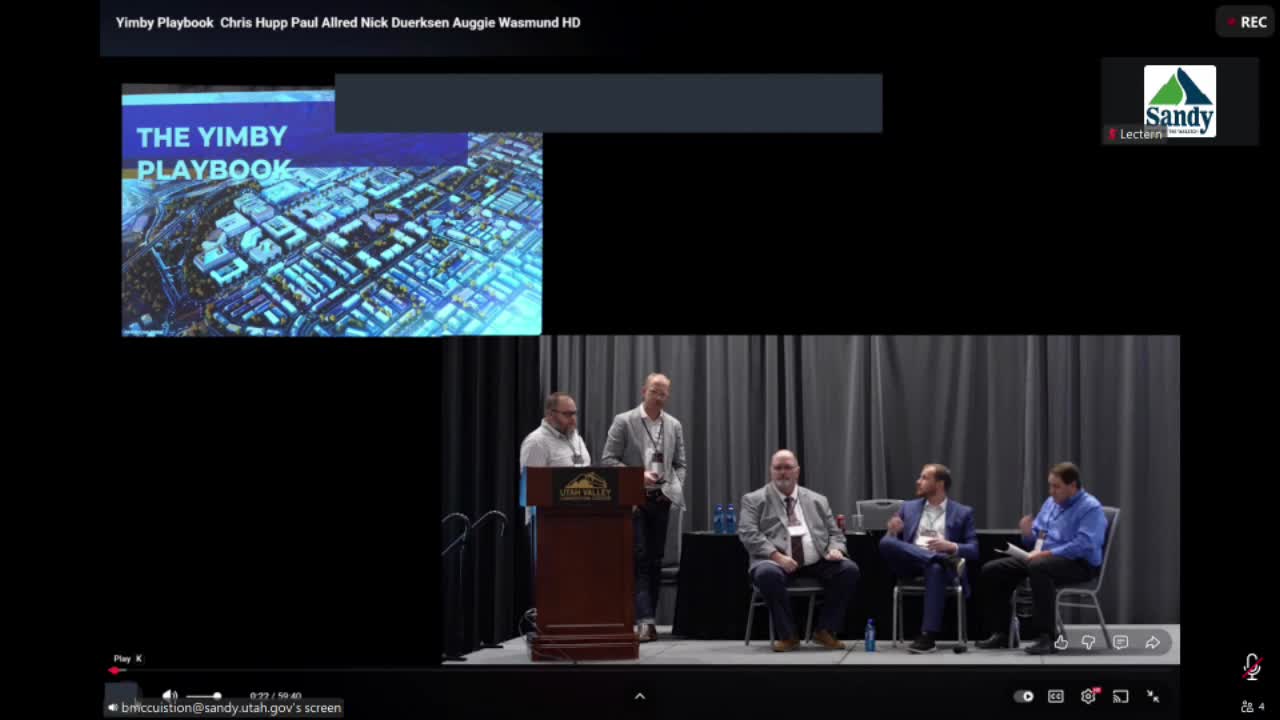Planners and developers offer playbook to counter NIMBY opposition
November 06, 2025 | Sandy, Salt Lake County, Utah
This article was created by AI summarizing key points discussed. AI makes mistakes, so for full details and context, please refer to the video of the full meeting. Please report any errors so we can fix them. Report an error »

Organizers convened a multi‑stakeholder workshop in Sandy to present what they called a "GMB playbook" of tactics for planning staff, developers and commissioners to respond to neighborhood opposition commonly labeled as NIMBYism.
Panelists—who included private‑sector developers, retired local planners and an APA representative—front‑loaded several repeatable steps they urged staff and applicants to use early in a project. "Probably the most common thing that we heard ... is we don't want density, and we don't want those people," one panelist said, summarizing the core public objection the playbook is meant to address.
The panel described four widely used tactics. First, meet opponents in small groups or one‑on‑one before hearings so staff can educate residents and resolve factual misunderstandings. "I'd go in the hallway during the public hearing and invite some of the most angry people out... let's talk," the former planner on the panel said, describing a technique he called "meeting trouble in the parking lot." Second, use photo simulations, rendered visuals and virtual walkthroughs so residents can see what a proposed building will actually look like instead of imagining worst‑case scenarios. A panelist who worked on stadium and canyon view projects illustrated how targeted images clarified scale and impact.
Third, bring neutral third‑party experts to address technical concerns such as traffic, drainage or environmental risk. Panelists said an independent traffic engineer, paid for by the city, often neutralized heated claims. "When they come in and say, 'this is much less than that,' the nimbyism really dropped off," a panelist said. Fourth, prepare and educate decision‑makers: panelists urged staff to help recruit and brief planning commissioners and to insist that commission chairs actively enforce hearing rules and time limits so no single speaker can dominate.
Speakers also addressed strategy and message. Use data to counter claims such as property‑value loss—panelists pointed to a white paper that staff can cite—and frame engagement around the most relevant, positive details rather than hypothetical negatives. Several panelists urged officials to be candid: "You must speak the truth. You can't chicken out," one former planner said, advising commissioners not to yield to pressure driven by re‑election concerns.
The workshop included multiple case studies from Utah cities, including strategies used when an old gravel pit became an amphitheater and retail center and when a proposed elderly care facility faced design‑related objections. Panelists repeatedly recommended splitting contentious items into separate special sessions or continuances so emotion does not carry over into unrelated votes.
The workshop closed with a procedural recommendation: after any raucous hearing, staff and commissioners should debrief to identify what went wrong and what to fix. Speakers said that post‑mortems reduce future conflict and improve outreach.
Panelists—who included private‑sector developers, retired local planners and an APA representative—front‑loaded several repeatable steps they urged staff and applicants to use early in a project. "Probably the most common thing that we heard ... is we don't want density, and we don't want those people," one panelist said, summarizing the core public objection the playbook is meant to address.
The panel described four widely used tactics. First, meet opponents in small groups or one‑on‑one before hearings so staff can educate residents and resolve factual misunderstandings. "I'd go in the hallway during the public hearing and invite some of the most angry people out... let's talk," the former planner on the panel said, describing a technique he called "meeting trouble in the parking lot." Second, use photo simulations, rendered visuals and virtual walkthroughs so residents can see what a proposed building will actually look like instead of imagining worst‑case scenarios. A panelist who worked on stadium and canyon view projects illustrated how targeted images clarified scale and impact.
Third, bring neutral third‑party experts to address technical concerns such as traffic, drainage or environmental risk. Panelists said an independent traffic engineer, paid for by the city, often neutralized heated claims. "When they come in and say, 'this is much less than that,' the nimbyism really dropped off," a panelist said. Fourth, prepare and educate decision‑makers: panelists urged staff to help recruit and brief planning commissioners and to insist that commission chairs actively enforce hearing rules and time limits so no single speaker can dominate.
Speakers also addressed strategy and message. Use data to counter claims such as property‑value loss—panelists pointed to a white paper that staff can cite—and frame engagement around the most relevant, positive details rather than hypothetical negatives. Several panelists urged officials to be candid: "You must speak the truth. You can't chicken out," one former planner said, advising commissioners not to yield to pressure driven by re‑election concerns.
The workshop included multiple case studies from Utah cities, including strategies used when an old gravel pit became an amphitheater and retail center and when a proposed elderly care facility faced design‑related objections. Panelists repeatedly recommended splitting contentious items into separate special sessions or continuances so emotion does not carry over into unrelated votes.
The workshop closed with a procedural recommendation: after any raucous hearing, staff and commissioners should debrief to identify what went wrong and what to fix. Speakers said that post‑mortems reduce future conflict and improve outreach.
View full meeting
This article is based on a recent meeting—watch the full video and explore the complete transcript for deeper insights into the discussion.
View full meeting

